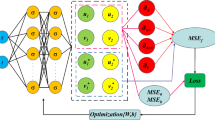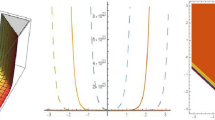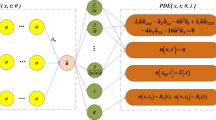Abstract
We use the physics-informed neural network to solve a variety of femtosecond optical soliton solutions of the high-order nonlinear Schrödinger equation, including one-soliton solution, two-soliton solution, rogue wave solution, W-soliton solution and M-soliton solution. The prediction error for one-soliton, W-soliton and M-soliton is smaller. As the prediction distance increases, the prediction error will gradually increase. The unknown physical parameters of the high-order nonlinear Schrödinger equation are studied by using rogue wave solutions as data sets. The neural network is optimized from three aspects including the number of layers of the neural network, the number of neurons, and the sampling points. Compared with previous research, our error is greatly reduced. This is not a replacement for the traditional numerical method, but hopefully to open up new ideas.







Similar content being viewed by others
References
Peregrine, D.H.: Water waves, nonlinear Schrodinger equations and their solutions. J. Aust. Math. Soc. Ser. B 25, 16–43 (1983)
Ablowitz, M.J., Clarkson, P.A.: Solitons, Nonlinear Evolution Equations and Inverse Scattering. Cambridge University Press, Cambridge (1992)
Han, H.B., Li, H.J., Dai, C.Q.: Wick-type stochastic multi-soliton and soliton molecule solutions in the framework of nonlinear Schrödinger equation. Appl. Math. Lett. 120, 107302 (2021)
Li, P.F., Li, R.J., Dai, C.Q.: Existence, symmetry breaking bifurcation and stability of two-dimensional optical solitons supported by fractional diffraction. Opt. Express 29, 3193–3209 (2021)
Wang, B.H., Wang, Y.Y., Dai, C.Q., Chen, Y.X.: Dynamical characteristic of analytical fractional solitons for the space-time fractional Fokas-Lenells equation. Alex. Eng. J. 59, 4699–4707 (2020)
Kodama, Y., Hasegawa, A.: Nonlinear pulse propagation in a monomode dielectric guide. IEEE J. Quantum Electron 23, 510–515 (1987)
Marcucci, G., Pierangeli, D., Conti, C.: Theory of neuromorphic computing by waves: machine learning by rogue waves, dispersive shocks, and solitons. Phys. Rev. Lett 125, 093901 (2020)
Bar-Sinai, Y., Hoyer, S., Hickey, J., et al.: Learning data driven discretizations for partial differential equations. PNAS 116, 15344–15349 (2019)
Zhang, R.F., Bilige, S.: Bilinear neural network method to obtain the exact analytical solutions of nonlinear partial differential equations and its application to p-gBKP equation. Nonlinear Dyn 95, 3041–3048 (2019)
Zhang, R.F., Bilige, S., et al.: Bright-dark solitons and interaction phenomenon for p-gBKP equation by using bilinear neural network method. Phys. Scr. 96, 025224 (2021)
Zhang, R.F., Li, M.C., et al.: Generalized lump solutions, classical lump solutions and rogue waves of the (2+1)-dimensional Caudrey-Dodd-Gibbon-Kotera-Sawada-like equation. Appl. Math. Comput. 403, 126201 (2021)
Urbaniak, I., Wolter, M.: Quality assessment of compressed and resized medical images based on pattern recognition using a convolutional neural network. Commun. Nonlin. Sci. Numer. Simul. 95, 105582 (2021)
Ge, C.P., Liu, Z., Fang, L.M., et al.: A hybrid fuzzy convolutional neural network based mechanism for photovoltaic cell defect detection with electroluminescence images. IEEE Trans. Parallel Distrib. Syst. 32, 1653–1664 (2021)
Alipanahi, B., Delong, A., Weirauch, M.T., Frey, B.J.: Predicting the sequence specificities of DNA-and RNA-binding proteins by deep learning. Nat. Biotech-nol 33, 831–838 (2015)
Duda, R.O., Hart, P.E., Stork, D.G.: Pattern Classification. Springer-Verlag, New York (2000)
Lake, B.M., Salakhutdinov, R., Tenenbaum, J.B.: Human-level concept learning through probabilistic program induction. Science 350, 1332–1338 (2015)
P. Johri, J. K. Verma, S. Paul (ed.), Applications of Machine Learning, Springer Singapore, (2020).
Lagaris, I.E., Likas, A., Fotiadis, D.I.: Artificial neural networks for solving ordinary and partial differential equations. IEEE Trans. Neural Netw 9, 987–1000 (1998)
Liu, Y., Yi, Xu., Ma, J.: Synchronization and spatial patterns in a light-dependent neural network. Commun. Nonlin. Sci. Numer. Simul. 89, 105297 (2020)
Raissi, M., Perdikaris, P., Karniadakis, G.E.: physics-informed neural networks: a deep learning framework for solving forward and inverse problems involving nonlinear partial differential equations. J. Compt. Phys. 378, 686–707 (2019)
Raissi, M., Karniadakis, G.E.: Hidden physics models: machine learning of nonlinear partial differential equations. J. Comput. Phys. 357, 125–141 (2018)
Raissi, M., Perdikaris, P., Karniadakis, G.E.: Numerical Gaussian processes for time-dependent and non-linear partial differential equations. SIAM J. Sci. Comput. 40, A172–A198 (2017)
Raissi, M., Yazdani, A., Karniadakis, G.E.: Hidden fluid mechanics: learning velocity and pressure fields from flow visualizations. Science 367, 1026–1030 (2020)
Jagtap, A.D., Kharazmi, E., Karniadakis, G.E.: Conservative physics-informed neural networks on discrete domains for conser-vation laws: Applications to forward and inverse problems. Comput. Methods Appl. Mech. Engrg 365, 113028 (2020)
Rudy, H.S., Brunton, S.L., Proctor, J.L., Kutz, J.N.: Data-driven discovery of partial differential equations. Sci. Adv. 3, 2375–2548 (2016)
Wang, L., Yan, Z.Y.: Data-driven rogue waves and parameter discovery in the defocusing NLS equation with a potential using the PINN deep learning. Phys. Lett. A 404, 127408 (2021)
Pu, J.C., Li, J., Chen, Y.: Soliton, breather and rogue wave solutions for solving the nonlinear schrodinger equation using a deep learning method with physical constraints. Chin. Phys. B (2021). https://doi.org/10.1088/1674-1056/abd7e3
Xu, Z.Y., Li, L., Li, Z.H., Zhou, G.S.: Modulation instability and solitons on a cw background in an optical fiber with higher-order effects. Phys. Rev. E 67, 026603 (2003)
Jagtap, A.D., Kawaguchi, K., Karniadakis, G.E.: Locally adaptive activation functions with slope recovery term for deep and physics-informed neural networks. Proc. R. Soc. A 476, 2239 (2020)
Tao, Y.S., He, J.S.: Multisolitons, breathers, and rogue waves for the Hirota equation generated by the Darboux transformation. Phys. Rev. E 85, 026601 (2012)
Stein, M.L.: Large sample properties of simulations using latin hypercube sampling. Technometrics 29, 143–151 (1987)
Xu, Z.Y., Li, L., Li, Z.H., Zhou, G.S.: Soliton interaction under the influence of higher-order effects. Optics Communications 210, 375–384 (2002)
Li, Z.H., Li, L., Tian, H.P., Zhou, G.S.: New types of solitary wave solutions for the higher order nonlinear Schrödinger equation. Phys. Rev. Lett 84, 18 (1999)
Tian, J.P., Tian, H.P., Li, Z.H., Kang, L.S., Zhou, G.S.: An inter-modulated solitary wave solution for the higher order nonlinear Schrödinger equation. Phys. Scr. 67, 325–328 (2003)
Acknowledgements
This work is supported by the Zhejiang Provincial Natural Science Foundation of China (Grant No. LR20A050001), the National Natural Science Foundation of China (Grant Nos. 12075210 and 11874324) and the Scientific Research and Developed Fund of Zhejiang A&F University (Grant No. 2021FR0009).
Author information
Authors and Affiliations
Corresponding authors
Ethics declarations
Conflict of interest
The authors have declared that no conflict of interest exists.
Ethical Standards
This research does not involve human participants and/or animals.
Additional information
Publisher's Note
Springer Nature remains neutral with regard to jurisdictional claims in published maps and institutional affiliations.
Y. Fang and G. Z. Wu contributed equally to this work.
Rights and permissions
About this article
Cite this article
Fang, Y., Wu, GZ., Wang, YY. et al. Data-driven femtosecond optical soliton excitations and parameters discovery of the high-order NLSE using the PINN. Nonlinear Dyn 105, 603–616 (2021). https://doi.org/10.1007/s11071-021-06550-9
Received:
Accepted:
Published:
Issue Date:
DOI: https://doi.org/10.1007/s11071-021-06550-9




